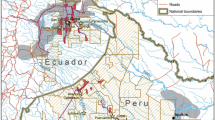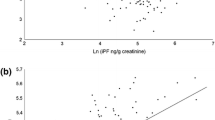Abstract
Objectives
To compare differences in pre- and post-shift urinary 1-hydroxypyrene (1OHP) levels as a measure of internal dose of polycyclic aromatic hydrocarbons (PAHs) between two groups of oil production workers offshore assumed to be exposed to PAH, and to compare the exposed group to an unexposed control group.
Methods
Participants’ (n = 42) urine samples, collected over a study period of three consecutive 12-h work days (pre-shift on the first day and post-shift on the third day), were analyzed using high performance liquid chromatography (HPLC) with fluorescence detection. Analysis of covariance was used in the statistical models.
Results
(1) Post-shift 1OHP levels were significantly higher in the exposed workers compared to the controls. (2) Tank workers and process operators did not show statistically significant different post-shift 1OHP levels.
Conclusion
Altogether, this study indicates the presence of a low level PAH exposure among offshore oil production workers.

Similar content being viewed by others
References
ACGIH (2005) Biological exposure index (BEI): polycyclic aromatic hydrocarbons (PAHs), p 17
Boogaard P, van Sittert N (1994) Exposure to polycyclic aromatic hydrocarbons in petrochemical industries by measurement of urinary 1-hydroxypyrene. Occup Environ Med 51:250–258. doi:10.1136/oem.51.4.250
Bråtveit M, Kirkeleit J, Hollund BE et al (2007) Biological monitoring of benzene exposure for process operators during ordinary activity in the upstream petroleum industry. Ann Occup Hyg 51:487–494
Buchet JP, Gennart JP, Mercado-Calderon F et al (1992) Evaluation of exposure to polycyclic aromatic hydrocarbons in a coke production and a graphite electrode manufacturing plant: assessment of urinary excretion of 1-hydroxypyrene as a biological indicator of exposure. Brit J Ind Med 49:761–768
Durell G, Utvik TR, Johnsen S et al (2006) Oil well produced water discharges to the North Sea. Part I: Comparison of deployed Mussels (Mytilus Edulis), semi-permeable membrane devices, and the DREAM Model Predictions to estimate the dispersion of polycyclic aromatic hydrocarbons. Mar Env Res 62:194–223
Faksness LG, Grini PG, Daling PS (2004) Partitioning of semi-soluble organic compounds between the water phase and oil droplets in produced water. Mar Pollut Bull 48:731–742
Hansen AM, Mathiesen L, Pedersen M et al (2008) Urinary 1-hydroxypyrene (1-HP) in environmental and occupational studies—a review. Int J Hyg Env Health 211:471–503
International Agency for Research on Cancer (IARC) (1983) IARC Monographs on the evaluation of carcinogenic risks of chemicals to humans. Polynuclear Aromatic Compounds Part 2. Chemical, Environmental and Experimental Data. Lyon 32
Jongeneelen FJ, Anzion RBM, Henderson PT (1987) Determination of hydroxylated metabolites of polycyclic aromatic hydrocarbons in urine. J Chrom 413:227–232
Kirkeleit J, Riise T, Bråtveit M et al (2006) Biological monitoring of benzene exposure during maintenance work in crude oil cargo tanks. Chemico-Biol Interactions 164:60–67
Lafontaine M, Gendre C, Morele Y et al (2002) Excretion of urinary 1-hydroxypyrene in relation to the penetration routes of polycyclic aromatic hydrocarbons. PAC 22:579–588
Lauwerys RR, Hoet P (1993) Industrial Chemical Exposure: Guidelines for Biological Monitoring. Lewis Publishers, Boca Raton, FL
SAS Institute Inc. (2000–2003) SAS Software, SAS System for Windows. Copyright© 2000–2003. SAS Institute Inc., Cary. Version 9.1
Schulz C, Conrad A, Becker K et al (2007) Twenty years of the German environmental survey (GerES): human biomonitoring—temporal and spatial (West Germany/East Germany) differences in population exposure. Int J Hyg Env Health 210:271–297
Succop PA, Clark S, Chen M et al (2004) Imputation of data values that are less than a detection limit. J Occ Env Hyg 1:436–441
Wang Z, Fingas M (1999) Identification of the source(s) of unknown spilled oils (review). J Chrom A 843:369–411
Wilhelm M, Hardt J, Schulz C et al (2008) New reference value and the background exposure for the PAH metabolites 1-hydroxypyrene and 1- and 2-naphthol in urine of the general population in Germany: basis for validation of human biomonitoring data in environmental medicine. Int J Hyg Env Health 211:447–453
Acknowledgments
We wish to thank Ms. Brenda L. Schumann for assistance in the laboratory and Dr. Howard Shertzer for use of the spectrophotometer. This research study was (partially) supported by the National Institute of Occupational Safety and Health and the Health Pilot Research Project Training Program of the University of Cincinnati Education and Research Center Grant #T42/OH008432-03. The collection of the samples was financed by the Research Council of Norway under the PETROMAKS programme.
Conflict of interest statement
The authors declare that they have no conflict of interest.
Author information
Authors and Affiliations
Corresponding author
Rights and permissions
About this article
Cite this article
Hopf, N.B., Kirkeleit, J., Kramer, S.L. et al. Urinary 1-hydroxypyrene levels in offshore workers. Int Arch Occup Environ Health 83, 55–59 (2010). https://doi.org/10.1007/s00420-009-0437-2
Received:
Accepted:
Published:
Issue Date:
DOI: https://doi.org/10.1007/s00420-009-0437-2




